Theoretical analysis of slip flow on a rotating cone with viscous dissipation effects*
2015-11-24SALEEMNADEEM
SALEEM S., NADEEM S.
1. Department of Mathematics, COMSATS Institute of Information Technology, Attock 43600, Pakistan,E-mail: salmansaleem_33@hotmail.com
2. Department of Mathematics, Quaid-I-Azam University, Islamabad 44000, Pakistan
Theoretical analysis of slip flow on a rotating cone with viscous dissipation effects*
SALEEM S.1, NADEEM S.2
1. Department of Mathematics, COMSATS Institute of Information Technology, Attock 43600, Pakistan,E-mail: salmansaleem_33@hotmail.com
2. Department of Mathematics, Quaid-I-Azam University, Islamabad 44000, Pakistan
This paper is concerned with the mutual effects of viscous dissipation and slip effects on a rotating vertical cone in a viscous fluid. Similarity solutions for rotating cone with wall temperature boundary conditions provides a system of nonlinear ordinary differential equations which have been treated by optimal homotopy analysis method (OHAM). The obtained analytical results in comparison with the numerical ones show a noteworthy accuracy for a special case. Effects for the velocities and temperature are revealed graphically and the tabulated values of the surface shear stresses and the heat transfer rate are entered in tables. From the study it is seen that the slip parameterγenhances the primary velocity while the secondary velocity reduces. Further it is observed that the heat transfer rateincreases with Eckert number Ec and Prandtl number Pr.
mixed convection, incompressible flow, differential equations, slip effects, viscous dissipation
Introduction
A study which involves the equivalent participation of both forced and natural convection is termed as mixed convection. It plays a key role in atmospheric boundary layer flows, heat exchangers, solar collectors, nuclear reactors and in electronic equipment's. Such processes occur when the effects of buoyancy forces in forced convection or the effects of forced flow in natural convection become much more remarkable. The interaction of both convections is mostly noticeable in physical situations where the forced convection flow has low velocity or moderate and large temperature differences. In the concerned analysis, a rotating cone is placed in a Newtonian fluid with the axis of the cone being in line with the external flow is inspected. The mixed convective heat transfer problems with cones are generally used by automobile and chemical industries. Some important applications are design of canisters for nuclear waste disposal, nuclear reactor cooling system, etc.. Practically, the unsteady mixed convective flows do not give similarity solutions and for the last few years, various problems have been deliberated, where the non-similarities are taken into account. The unsteadiness and non-similarity in such type of flows is due to the free stream velocity,the body curvature, the surface mass transfer or even possibly due to all these effects. The crucial mathematical difficulties elaborate in finding non-similar solutions for such studies have bounded several researchers to confine their studies either to the steady nonsimilar flows or to the unsteady semi-similar or selfsimilar flows. A solution is recognized as self-similar if a system of partial differential equations can be reduced to a system of ordinary differential equations. If the similarity transformations are able to reduce the number of independent variables only, then the reduced equations are named semi-similar and the corresponding solutions are the semi-similar solutions. Hering and Grosh[1]studied steady mixed convection boundary layer flow from a vertical cone in an ambient fluid for the Prandtl number of air. Himasekhar et al.[2]carried out the similarity solution of the mixed convection boundary layer flow over a vertical rota-ting cone in an ambient fluid for a wide range of Prandtl numbers. A few years back, Anilkumar and Roy[3]obtained the self-similar solutions of unsteady mixed convection flow from a rotating cone in a rotating fluid. Unsteady heat and mass transfer from a rotating vertical cone with a magnetic field and heat generation or absorption effects were examined by Chamkha and Al-Mudhaf[4].The non-similar solution to study the effects of mass transfer (suction/injection)on the steady mixed convection boundary layer flow over a vertical permeable cone were presented by Ravindran et al.[5]. Also Nadeem and Saleem[6]explore the analytical study of mixed convection flow of non-Newtonian fluid on a rotating cone. Hall effects on unsteady flow due to noncoaxially rotating disk and a fluid at infinity were presented by Hayat et. al.[7]. Fluids revealing slip are significant in technological applications such as in the polishing of artificial heart valves and internal cavities. Slip also occurs on hydrophobic surfaces, particularly in micro- and nano-fluidics. Makinde and Osalsui[8]studies MHD steady flow in a channel with slip at the permeable boundaries. Ellahi et. al.[9]examined the study of generalized Couette flow of a third grade fluid with slip: the exact solutions. Some relevant studies on this phenomenon are given in Refs.[10-15]. The influence of variable viscosity and viscous dissipation on the non-Newtonian flow was explored by Hayat et. al.[16].
In general it is challenging to handle nonlinear problems, especially in an analytical way. Perturbation techniques like variation of iteration method(VIM) and homotopy perturbation method (HPM)[17,18]were frequently used to get solutions of such mathematical investigation. These techniques are dependent on the small/large constraints, the supposed perturbation quantity. Unfortunately, many nonlinear physical situations in real life do not always have such nature of perturbation parameters. Additional, both of the perturbation techniques themselves cannot give a modest approach in order to adjust or control the region and rate of convergence series. Liao[19]presented an influential analytic technique to solve the nonlinear problems, explicitly the homotopy analysis method(HAM). It offers a suitable approach to control and regulate the convergence region and rate of approximation series, once required.
Encouraged by all above findings, the main emphasis of the present paper is to examine the effects of slip on boundary layer flow over a rotating cone in a viscous fluid with viscous dissipation. The concerned nonlinear partial differential for rotating cone are transformed to system of nonlinear ordinary differential equations with proper similarity transformations and then solved by optimal homotopy analysis method(OHAM)[19-29]. Also the effects of related physical parameters on velocities, surface stress tensors, temperature and heat transfer rate are reported and discussed through graphs and tables.
1. Analysis of the problem
Consider the unsteady, axi-symmetric, incompressible viscous fluid flow of over a rotating cone in a Newtonian fluid. It is assumed that only the cone is in rotation with angular velocity which is a function of time. This develops unsteadiness in the flow field. Rectangular curvilinear coordinate system is taken to be fixed. Hereu,vandw be the components of velocity inx,yand z-directions, respectively. The temperature as well as concentration variations in the flow fluid are responsible for the existence of the buoyancy forces. The gravitygacts downward in the direction of axis of the cone. Moreover, the wall temperature Twand wall concentration Cware linear functions ofx , while the temperature T∞and concentrationC∞far away from the cone surface are taken to be constant. The physical model and coordinate system is shown in Fig.1.
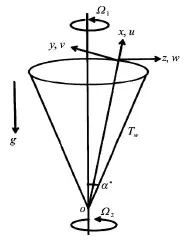
Fig.1 Physical model and coordinate system
By using Boussinesq approximation and boundary layer theory, the governing momentum and energy equations are deliberated as:
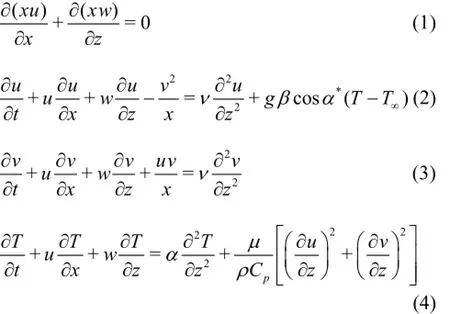
whereνis the kinematic viscosity,ρis the density,g is the gravity,α∗is the semi-vertical angle of the cone,βis the volumetric coefficient of expansion for temperature,αis the thermal diffusivity and Cpspecific heat of the fluid.
The boundary conditions appropriate to the viscous flow problem are stated below
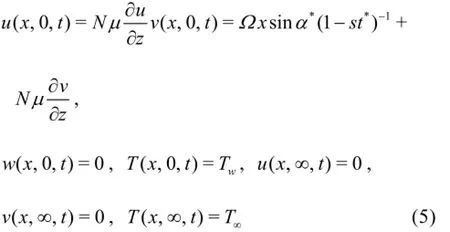
here Ωis the dimensionless angular velocity of the cone,T∞is the temperature far away from fluid,N is the velocity slip factor andt∗is the dimensionless time.
It is suitable to reduce system of partial differential equations in to nonlinear ordinary differential equations with the help of following similarity transformation[3].
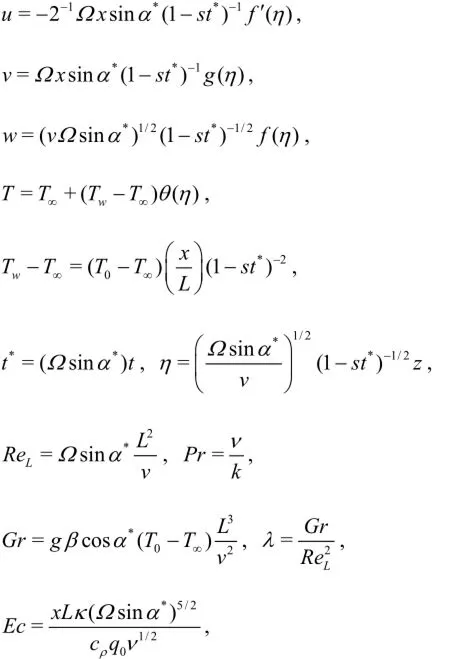

The Eq.(3) is trivially satisfied and Eqs.(4) and (7)takes the form
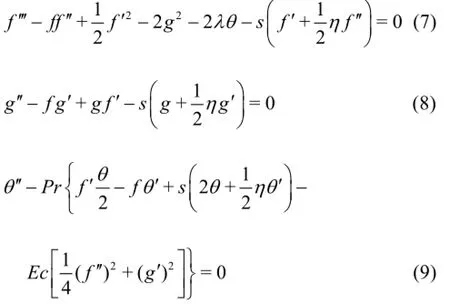
here λis the mixed convection parameter,sis the unsteady parameter and the flow is accelerated for s>0and retarded for s<0,Pris the Prandtl number,Ecis the Eckert number andγis the slip parameter.
The boundary conditions in non-dimensional form for the concerned flow problem are given as:

The surface stress tensors in primary and seconddary directions for the present analysis are:

or in dimensionless form

The heat transfer coefficient in dimensionless form is stated as

2. Optimal homotopy analysis procedure
The solutions of the coupled nonlinear parabolic ordinary differential equations given in Eqs.(10)-(13)are carried out analytically by optimal homotopy analysis method (OHAM) which was established by Liao[12]. The following initial guesses and linear operators for velocity components and temperature fields are used f0,g0and θ0respectively is
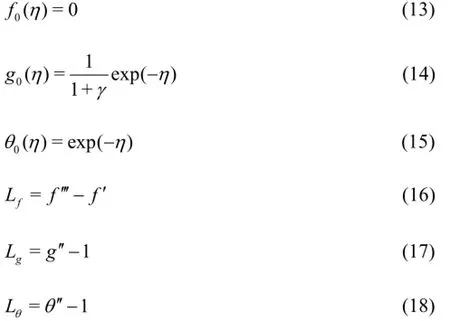
The standard procedure of homotopy analysis method can be follow as[19,29].
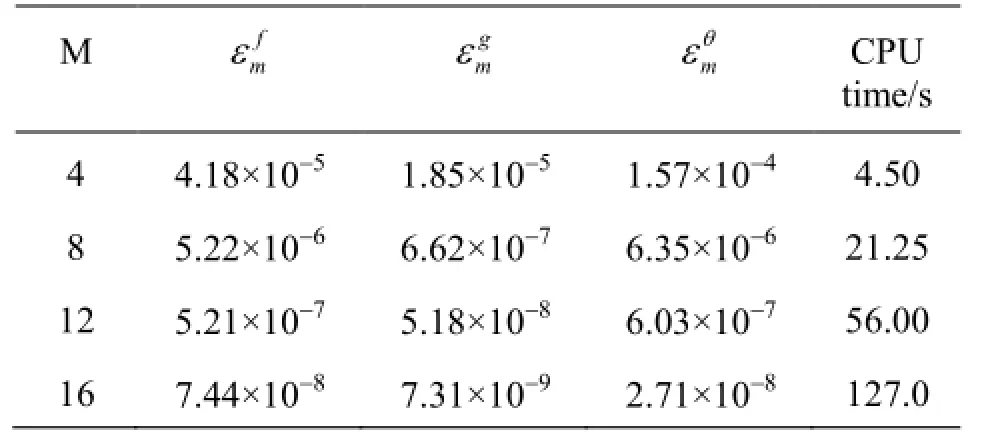
Table 1 Local optimal convergence control paraments and total averaged squared residual errors using BVPh2.0
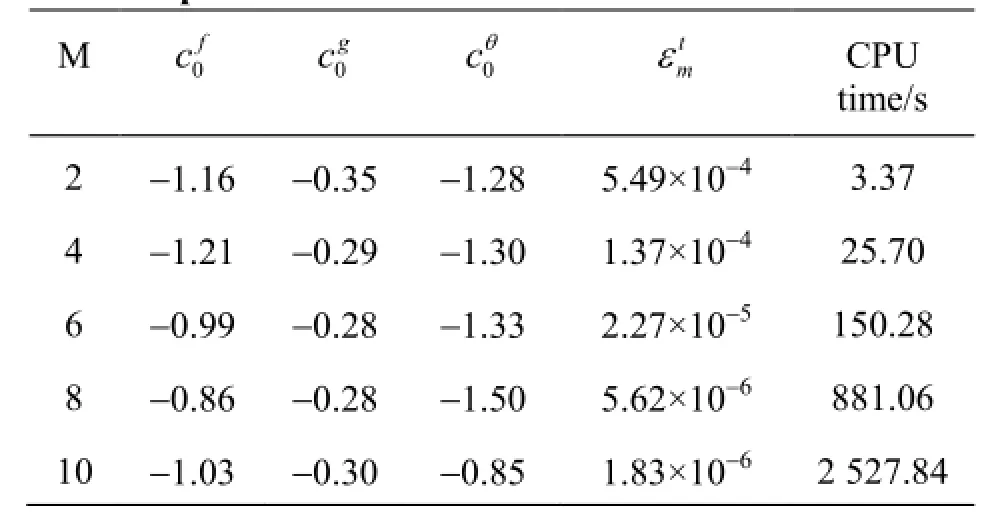
Table 2 Individual averaged squared residual errors using optimal values at m =10from Table 1
Generally homotopy analysis solutions involve the non-zero auxiliary parameters,andhich are helpful in finding the convergence-region and rate of the homotopy series solutions. In order to attain the optimal values of non-zero auxiliary parameters,andit is used here the so-called average residual error specified by[19].
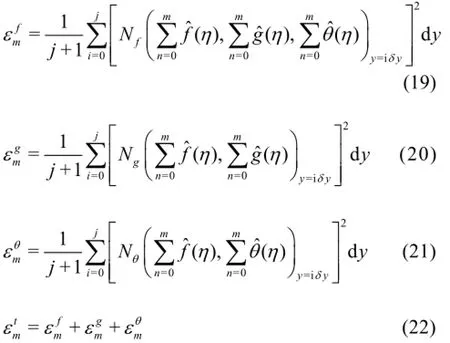
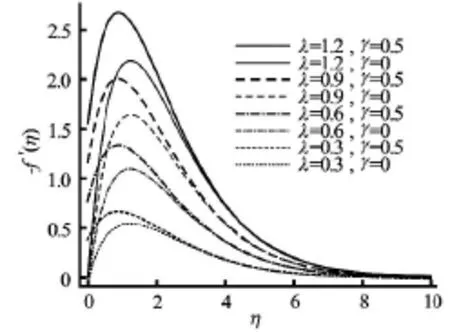
Fig.2 Variation of -f′(η)for λ
3. Results and discussion
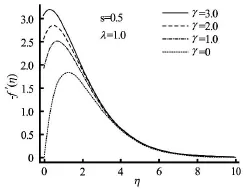
Fig.3 Variation of -f′(η)for γ
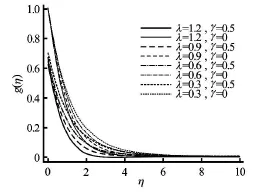
Fig.4 Variation of g(η)for λ
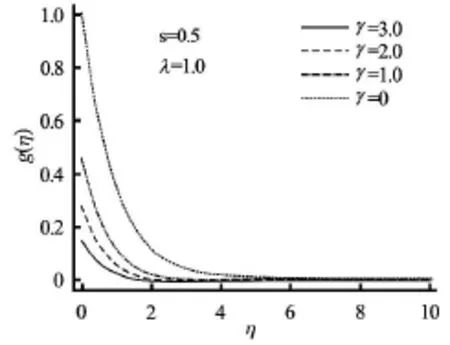
Fig.5 Variation of g(η)forγ
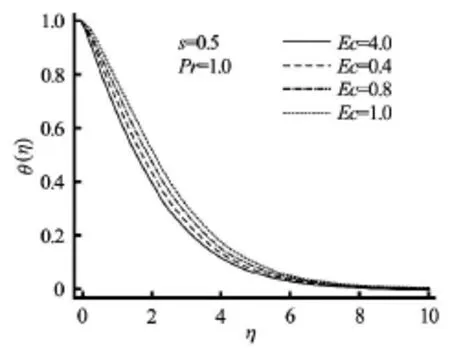
Fig.6 Variation of θ(η)forEc
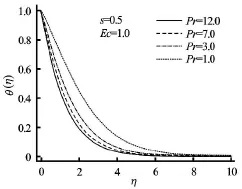
Fig.7 Variation of θ(η)for Pr
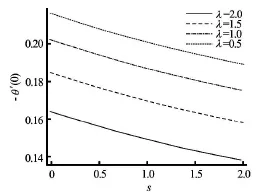
Fig.8 Variation of -θ′(0)for λ
This portion of study involves the graphical and numerical results of various significant parameters on velocities, temperature, surface stress coefficients and heat transfer coefficient. Such variations have been observed in Figs.2-7. Figure 2 is sketched to display the behavior of primary velocity -f′(η)for mixed convection parameterλin the presence of slip and no slip parameters. The positive buoyancy parameter acts like a favorable pressure gradient, with property to accelerate the fluid. It is expected from Fig.2 that -f′(η)and boundary layer thickness increases with increasing values ofλ, further it is noticed that the primary velocity -f′(η)has greater magnitude for γ=0.5(i.e., in the presence of slip parameter). The influence of slip parameterγon primary velocity -f′(η)is shown in Fig.3. It is devoted from the figure that-f′(η)enhances its magnitude with an increase inγ. The influence of mixed convection parameterλand slip parameterγis to reduce the secondary velocityg(η)respectively (See Fig.4 and 5). Moreover it is seen that the secondary velocityg(η)has least magnitude for γ=0.5(i.e., in the presence of slip parameter). Figure 6 is devoted to show the influence of Eckert numberEcon temperature θ(η). The figure shows that the temperatureθ(η)is anincreasing function of Ec. The influence of the Prandtl numberPron the temperature is drafted in Fig.7. It is clear from the respective figure that θ(η)as well as the thermal boundary layer thickness decrease forPr. Physically the fluid with higher Prandtl number has a lower thermal conductivity which effects in thinner thermal boundary layer and as a result heat transfer rate rises. For engineering phenomenon, the heat transfer rate must be small. This can be retained by keeping the low temperature difference between the surface and the free stream fluid, using a low Prandtl number fluid, keeping the surface at a constant temperature instead of at a constant heat flux, and by smearing the buoyancy force in the contrasting direction to that of forced flow. Figure 8 is sketched to observe the behavior of Nusselt number on mixed convection parameter λ. It is depicted that -θ′(0)decreases with increasingλ. In order to get the authentication of accuracy of the analytical scheme, a comparison of the present results equivalent to the surface stress coefficients and heat transfer coefficient for γ=s=Ec=0 with published literature of Chamkha et al.[4]and Himasekhar et al.[2]is presented and is found to be in remarkable agreement given in Table 3. Table 4 involves the numerical values of surface stress tensors for pertinent parameters. It is found from the table that the tangential surface stress tensor Cfxincreases for slip parameterγ, but the variation is just opposite for azimuthal surface stress tensor 0.5Cfy. Mixed convection parameterλand the unsteady parameterScause an increase in surface stress tensors in both directions (see Table 4). Table 5 depicts that as unsteady parameterSincreases from -0.5 to 0.5, heat transfer rate Nudecreases. Similar behavior is observed for Eckert number. Moreover, it is seen that the Prandtl numberPrenhances the variation of heat transfer rate Nu.

Table 3 Comparison of values of Skin friction coefficients and heat transfer for s=γ=Ec=0
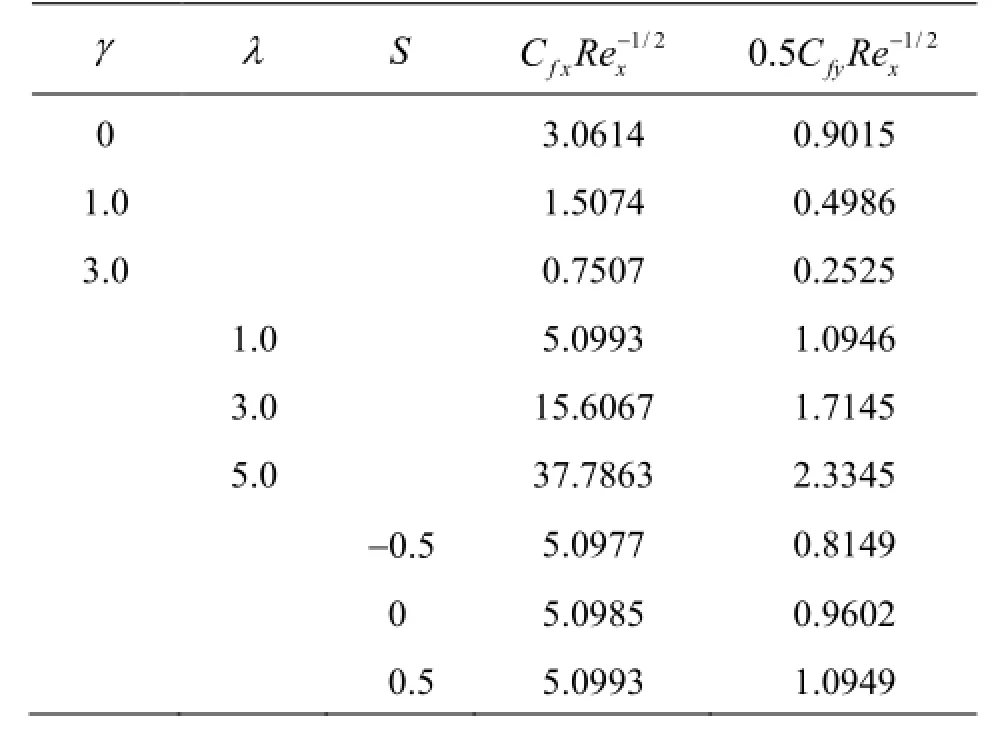
Table 4 Values for surface shear stresses when Pr=1.0 and Ec=0.5
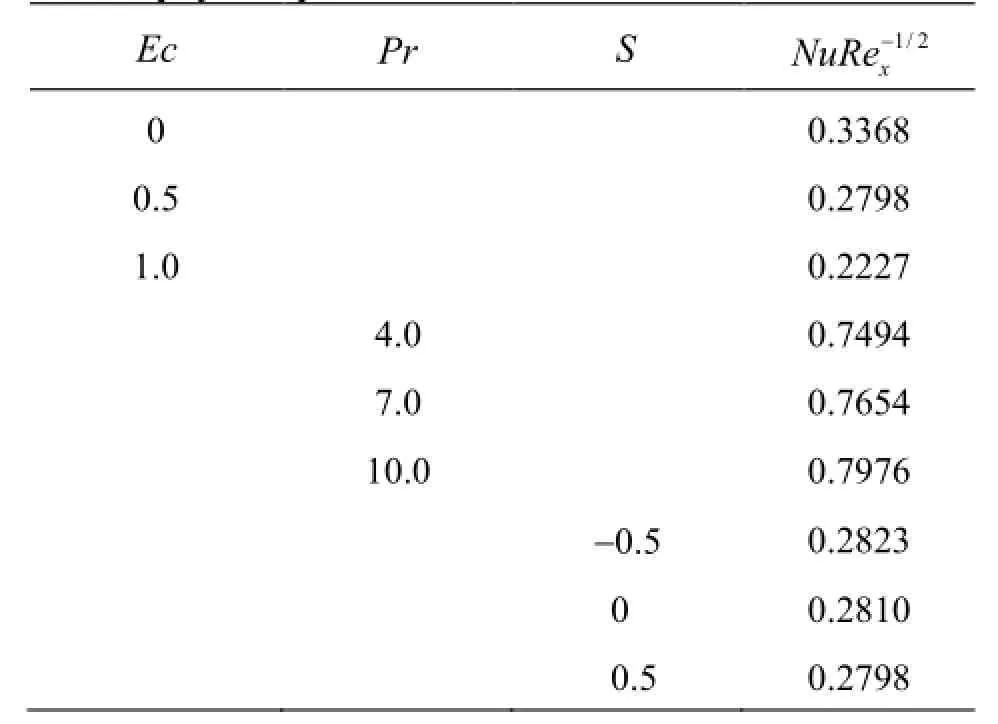
Table 5 Values for reduced Nusselt number for interesting physical parameters
4. Concluding remarks
In this study we have deliberated the effects of slip on mixed convection flow of a fluid on a rotating cone in a viscous fluid with viscous dissipation. The non-linear partial differential equations are primarily reduced to a system of non-linear ordinary differential equation and then the solution is effectively carried out by optimal homotopy analysis method. The results shows that:
(1) The primary velocity increases and secondary velocity decreases for both mixed convection parameterλand slip parameterγrespectively.
(2) Surface stress tensor inx -direction Cfxenhances its magnitude for mixed convection parameterλand unsteady parameter s, but possess opposite variation for slip parameterγ.
(3) Temperature field is an increasing function of Eckert numberEc.
(4) The heat transfer rate Nuhas opposite variation Prandtl numberPr and Eckert number Ec.
References
[1]HERING R. G., GROSH R. J. Laminar free convection from a non-isothermal cone[J]. International Journal of Heat and Mass Transfer, 1962, 5(11): 1059-68.
[2]HIMASEKHAR K., SARMA P. K. and JANARDHAN K. Laminar mixed convection from a vertical rotating cone[J]. International Communications in Heat and Mass Transfer, 1989, 16(1): 99-106.
[3]ANILKUMAR D., ROY S. Unsteady mixed convection flow on a rotating cone in a rotating fluid[J]. Applied Mathematics and Computation, 2004, 155(2): 545-561.
[4]CHAMKHA A. J., AL-MUDHAF A. Unsteady heat and mass transfer from a rotating vertical cone with a magnetic field and heat generation or absorption effects[J]. International Journal of Thermal Sciences, 2005,44(3): 267-276.
[5]RAVINDRAN R., ROY S. and MOMONIAT E. Effects of injection (suction) on a steady mixed convection boundary layer flow over a vertical cone[J]. International Journal of Numerical Methods for Heat and Fluid Flow, 2009, 19(19): 432-444.
[6]NADEEM S., SALEEM S. Analytical study of rotating non-Newtonian nanofluid on a rotating cone[J]. Journal of Thermophysics Heat Transfer, 2014, 28(2):295-302.
[7]HAYAT T., ELLAHI R. and ASGHAR S. Hall effects on unsteady flow due to noncoaxially rotating disk and a fluid at infinity[J]. Chemical Engineering Commu- nications, 2008, 195(8): 958-976.
[8]MAKINDE O. D., OSALSUI E. MHD steady flow in a channel with slip at the permeable boundaries[J]. Ro- manian Journal of Physics, 2006, 51: 319-328.
[9]ELLAHI R., HAYAT T. and MAHOMED F. M. Generalized Couette flow of a third grade fluid with slip: The exact solutions[J]. Zeitschrift Für Naturforschung A, 2010, 65: 1071-1076.
[10] ELLAHI R., HAYAT T. and MAHOMED F. M. et al. Effects of slip on the non-linear flows of a third grade fluid[J]. Nonlinear Analysis: Real World Applicatio- ns, 2010, 11(1): 139-146.
[11] MAKINDE O. D. Computational modeling of MHD unsteady flow and heat transfer towards flat plate with Navier slip and Newtonian heating[J]. Brazilian Jour- nal of Chemical Engineering, 2012, 29(1): 159-166.
[12] HAJMOHAMMADI M. R.,NOURAZARS. S. On the insertion of a thin gas layer in micro cylindrical Couette flows involving power-law liquids[J]. International Journal of Heat and Mass Transfer, 2014, 75: 97-108.
[13]HAJMOHAMMADI M. R.,NOURAZAR S. S. and CAMPOA. Analytical solution for two-phase flow between two rotating cylinders filled with power law liquid and a micro layer of gas[J]. Journal of Mechanical Science and Technology, 2014, 28(5): 1849- 1854.
[14] KHAN W. A., KHAN Z. H. and RAHI M. Fluid flow and heat transfer of carbon nanotubes along a flat plate with Navier slip boundary[J]. Applied Nanoscience, 2014, 4(5):633-641.
[15] QASIM M., KHAN Z. H. and KHAN W. A. et al. MHD boundary layer slip flow and heat transfer of ferrofluid along a stretching cylinder with prescribed heat flux[J]. PLoS ONE, 2014, 9(1): e83930.
[16] HAYAT T., ELLAHI R. and ASGHAR S. The influence of variable viscosity and viscous dissipation on the non-Newtonian flow: An analytical solution[J]. Communications in Nonlinear Science and Numerical Simulation, 2007, 12(3): 300-313.
[17] KHAN Z. H.,RAHIM G. and KHAN W. A. Effect of variable thermal conductivity on heat transfer from a hollow sphere with heat generation using homotopy perturbation method[C]. ASME 2008, Heat Transfer Summer Conference. Jacksonville, Florida, USA,2008, 301-309.
[18]RAHIM G., KHAN Z. H. and KHAN W. A. Heat transfer from solids with variable thermal conductivity and uniform internal heat generation using homotopy perturbation method[C]. ASME 2008 Heat Transfer Summer Conference collocated with the Fluids Engineering, Energy Sustainability, and 3rd Energy Nanotechnology Conferences. Jacksonville, Florida, USA, 2008, 1: 311-319.
[19] LIAO S. An optimal homotopy-analysis approach for strongly nonlinear differential equations[J]. Communications in Nonlinear Science and Numerical Simula- tions, 2010, 15(8): 2003-2016.
[20] NADEEM S., MEHMOOD R. and AKBAR N. S. Optimized analytical solution for oblique flow of a Casson-nano fluid with convective boundary conditions[J]. International Journal of Thermal Sciences,2014, 78(1): 90-100.
[21]ABBASBANDY S. Homotopy analysis method for generalized Benjamin-Bona-Mahony equation[J]. Zeitschrift Für Angewandte Mathematik Und Physik Zamp, 2008, 58: 51-62.
[22] ELLAHI R.The effects of MHD and temperature dependent viscosity on the flow of non-Newtonian nanofluid in a pipe: Analytical solutions[ J]. Applied Mathemati- cal Modelling, 2013, 37(3): 1451-1467.
[23] NADEEM S., HUSSAIN S. T. Heat transfer analysis of Williamson fluid over exponentially stretching surface[J]. Applied Mathematics and Mechanics (English Edition), 2014, 35(4): 489-502.
[24] QASIM M., NOREEN S. Falkner-Skan flow of a maxwell fluid with heat transfer and magnetic field[J]. International Journal of Engineering Mathematics, 2013, Article ID 692827.
[25] NADEEM S., SALEEM S. Unsteady mixed convection flow of nanofluid on a rotating cone with magnetic field[J]. Applied Nanoscience, 2013, 4(4): 405-414.
[26]ELLAHI R., RAZA M. and VAFAI K. Series solutions of non-Newtonian nanofluids with Reynolds' model and Vogel's model by means of the homotopy analysis method[J]. Mathematical and Computer Modelling,2012, 55(7): 1876-1889.
[27]HAJMOHAMMADI M. R.,NOURAZAR S. S. and MANESH A. H. Semi-analytical treatments of conjugate heat transfer[J]. Journal of Mechanical Engineering Science, 2012, 227: 492-503.
[28] HAJMOHAMMADI M. R.,NOURAZARS. S. On the solution of characteristic value problems arising in linear stability analysis. Semi analytical approach[J]. Applied Mathematics and Computation, 2014, 239(2): 126-132.
[29] NADEEM S., SALEEM S. Mixed convection flow of eyring-powell fluid along a rotating cone[J]. Results in Physics, 2014, 4: 54-62.
(August 10, 2014, Revised September 25, 2014)
* Biography: SALEEM S. (1986-), Male, Ph. D.,Assistant Professor
杂志排行
水动力学研究与进展 B辑的其它文章
- The analysis of flow characteristics in multi-channel heat meter based on fluid structure model*
- Numerical and experimental study of Boussinesq wall horizontal turbulent jet of fresh water in a static homogeneous environment of salt water*
- Development of integrated catchment and water quality model for urban rivers*
- Analysis of temperature time series based on Hilbert-Huang Transform*
- A cavitation aggressiveness index within the Reynolds averaged Navier Stokes methodology for cavitating flows*
- RANS simulations of the U and V grooves effect in the subcritical flow over four rotated circular cylinders*
